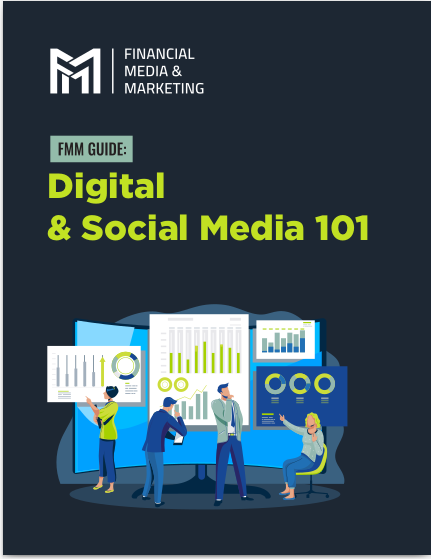Key Takeaways
-
Aligning your social media strategy with long-term business goals fosters genuine client relationships and measurable growth.
-
Engaging, authentic content and strategic communication help turn followers into loyal clients.
Why Social Media Needs to Support Your Big Picture Goals
Social media has evolved beyond simple likes and shares. For financial advisors like yourself, it’s more than just posting content; it’s about building trust, credibility, and meaningful relationships that contribute to your overall business objectives. Every post, comment, or interaction should align with a broader strategy that connects to your long-term goals.
Whether you’re aiming to attract new leads, nurture existing clients, or position yourself as an industry expert, your social media presence must have purpose. After all, random posting without direction can waste valuable time and resources. It’s time to focus on engagement that matters—real conversations, valuable content, and connections that drive growth.
Step 1: Define Your Long-Term Goals and Social Media Strategy
Before you start posting, you need clarity. Ask yourself: What am I trying to achieve? Here are a few common long-term goals for financial advisors:
-
Attract New Leads: Expand your client base by reaching potential prospects who need financial guidance.
-
Strengthen Existing Client Relationships: Use social platforms to stay top of mind, share valuable insights, and encourage ongoing trust.
-
Boost Your Credibility: Position yourself as a thought leader by sharing your expertise.
Once you identify your long-term objectives, you can create a social media strategy that aligns with those goals. Set specific, measurable metrics—like increasing follower count by 10% in three months, boosting engagement rates, or generating new consultations.
Take your time to outline what platforms work best for your audience, what type of content resonates with them, and how often you need to post to stay relevant without overwhelming them.
Step 2: Understand Your Audience’s Needs
If you want real engagement, you need to understand your audience. Social media is not about blasting sales messages or constantly touting your services—it’s about meeting people where they are and offering content they actually value.
Ask yourself:
-
What problems are my clients trying to solve?
-
What financial concerns do my leads have?
-
What type of content do they prefer? (Tips, videos, infographics, or long-form insights?)
Engagement happens when your content connects with your audience’s needs. For example, if you work with pre-retirees, you might focus on content about planning for retirement income or navigating Social Security. If your audience is younger professionals, financial literacy and investment basics might resonate more.
Don’t be afraid to interact directly with your audience by asking questions, running polls, or encouraging feedback. The more you listen to them, the better you can tailor your approach.
Step 3: Create Content That Builds Trust and Connection
Content is where the magic happens. Your audience doesn’t just want to hear about financial products or dry advice—they want relatable, insightful, and human content that adds value.
Types of Content That Engage
-
Educational Content: Share tips, guides, and insights that answer common financial questions.
-
Storytelling: Use stories to make complex concepts relatable. Discuss the importance of planning or share anonymous success stories.
-
Personal Updates: Showcase your personality and values—this helps clients connect with you as a person, not just a financial advisor.
-
Interactive Posts: Ask questions, host Q&A sessions, or conduct polls to involve your audience.
Balance Promotional and Value-Driven Content
While you want to showcase your services, keep promotional posts to a minimum. Focus instead on providing value that builds trust. An 80/20 rule works well—80% value-driven content, 20% promotion.
For example, you can share a quick tip about managing market volatility one day and offer a free resource about financial planning another day. If your audience trusts you for valuable insights, they’ll naturally look to you when they need personalized financial advice.
Step 4: Maintain Consistency Without Overdoing It
Consistency is key to building engagement, but that doesn’t mean you need to post all the time. Posting too frequently can overwhelm your audience, while posting too little can cause you to lose momentum. So what’s the balance?
Plan a Content Calendar
Create a weekly or monthly content calendar to:
-
Organize your posts ahead of time.
-
Maintain variety (educational, promotional, and personal content).
-
Align your content with key events, like tax season, retirement deadlines, or market updates.
Quality Over Quantity
It’s better to post 3-4 times a week with high-quality content than to churn out multiple posts with little value. Your audience will appreciate posts that are well thought-out and offer real solutions to their problems.
Step 5: Use the Right Tools to Engage Efficiently
Social media doesn’t have to be a time-consuming task. The right tools can help you stay organized, streamline your posting schedule, and track performance.
-
Social Media Management Tools: These allow you to plan, schedule, and automate posts in advance, so you’re not scrambling daily.
-
Analytics Tools: Measure how well your posts perform—look at metrics like engagement rates, comments, shares, and follower growth to see what’s working.
-
Client Communication Tools: Use messaging features to respond quickly to questions, build rapport, and nurture relationships.
By using these tools, you can maintain a strong presence without sacrificing too much time or energy.
Step 6: Focus on Real Conversations, Not Just Vanity Metrics
Vanity metrics like likes and followers are great, but they don’t always translate to business growth. Instead, focus on the quality of engagement—real conversations with leads and clients.
How to Spark Meaningful Conversations
-
Respond Quickly: Reply to comments and messages as soon as possible.
-
Ask Questions: Invite your audience to share their thoughts and concerns.
-
Be Authentic: Speak like a human, not a robot. Avoid jargon-heavy language and instead keep things conversational.
Engaging with your audience directly shows that you care about their needs and value their time. The goal is to move these online conversations toward real-world actions, like booking a consultation or attending a workshop.
Step 7: Track Your Results and Adjust Your Approach
Social media success doesn’t happen overnight. It takes time, effort, and a lot of learning to get it right. That’s why it’s essential to track your performance regularly.
Key Metrics to Monitor
-
Engagement Rate: Are people liking, sharing, and commenting on your content?
-
Click-Through Rate: Are your posts driving traffic to your website or booking links?
-
Lead Generation: How many new leads or inquiries come through social media?
Use this data to identify what’s working and what isn’t. If certain types of posts perform well, focus on creating more of that content. If engagement drops, experiment with new formats or adjust your posting frequency.
Strengthen Your Social Media Game for Long-Term Success
Building engagement on social media takes a thoughtful approach and a commitment to serving your audience. By aligning your strategy with long-term business goals, creating valuable content, and focusing on real conversations, you can turn your social media efforts into lasting relationships that support your success.
Consistency, authenticity, and adaptability are the keys to achieving meaningful engagement. Don’t just chase followers—build connections that matter.










